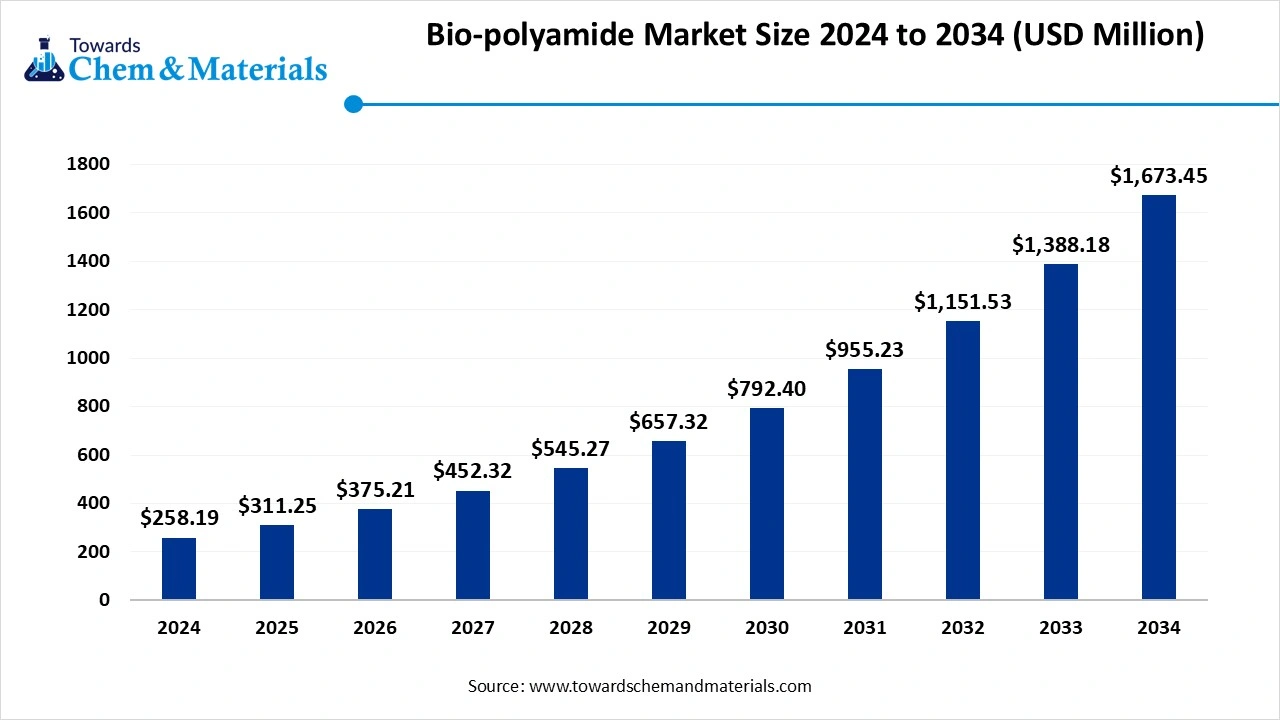Content
Bio-Polyamide Market Size and Growth 2025 to 2034
The global bio-polyamide market size was valued at USD 258.19 million in 2024. The market is projected to grow from USD 311.25 million in 2025 to USD 1673.45 million by 2034, exhibiting a CAGR of 20.55% during the forecast period. The rising demand for sustainable materials amid rising environmental concerns, technological advancements to enhance properties, and a shift towards sustainable practices and demand from various industries drive the growth of the market.
Key Takeaways
- The bio-polyamide market in Europe dominated the global industry and accounted for the largest revenue share of 37.55% in 2024
- By product, the PA-66 segment dominated the market with the largest share of over 51.38% in 2024.
- By application, the engineering plastics segment dominated the market and accounted for the largest share of 68.54% in 2024.
- By end use, the automotive segment dominated the market and accounted for the largest share of over 35.45% in 2024.
Market Overview
Rising Demand for Durable Materials: Bio-Polyamide Market to Expand
Bio-polyamide, also known as bio-nylon, is a type of polyamide (nylon) made from renewable resources like plants, microorganisms, or agricultural waste, rather than traditional petroleum-based sources. This offers a more sustainable alternative to traditional nylon production, reducing the need for fossil fuels and cutting greenhouse gas emissions. By using renewable resources and potentially less fossil energy in production, bio-polyamides have lower carbon footprints than traditional nylon, which helps reduce environmental impact. They're used in various applications, including textiles, engineering plastics, and films, with performance characteristics similar to their petroleum-based counterparts. Examples of bio-polyamides include PA 5.6, which uses sugar to create monomers, and Kalix HPPA, which can replace metal in some applications.
What Are the Key Growth Drivers Responsible for The Growth of The Market?
The growth of the bio-polyamide market is driven by various factors, like rising demand for sustainable materials amid rising environmental concerns, and growing environmental awareness amid growing concerns, and demand for bio-based and biodegradable alternatives drives the growth of the market. The growth is also driven by the bio-polyamide's diverse applications in various industries like textile, films, automotive, packaging, composites, and engineering plastics due to their performance properties and its benefits offering resulting in the growth of the market. The growing need for like chemical resistance, lightweight, mechanical and thermal resistance, improved fuel efficiency, and its versatility drives the growth of the market and also supports the expansion of the market.
Market Trends
- Growing demand for sustainable materials amid growing environmental concerns drives the demand for bio-polyamides, a sustainable alternative to traditional petroleum-based polyamides.
- Technological advancements to improve durability, performance, and thermal stability are a growing trend in the market, which helps grow the market.
- A wide range of applications in various industries like automotive, textile, and electronics, an alternative to traditional materials due to its strength and thermal resistance, drives the growth.
- Advancement in production processes to help lower production costs is a growing trend in the market, which supports the growth of the market.
Report Scope
| Report Attributes | Details |
| Market Size in 2025 | USD 311.25 Million |
| Expected Size by 2034 | USD 1673.45 Million |
| Growth Rate from 2025 to 2034 | CAGR 20.55% |
| Base Year of Estimation | 2024 |
| Forecast Period | 2025 - 2034 |
| Dominant Region | Europe |
| Segment Covered | By Product, By Application, By End-use, By Region |
| Key Companies Profiled | Evonik Industries AG, Huntsman International LLC, LANXESS, BASF SE, UBE Corporation, INVISTA, DOMO Chemicals GmbH, Arkema, Asahi Kasei Corporation, Honeywell International Inc., DSM, TORAY INDUSTRIES, INC., Radici Partecipazioni SpA, DuPont, Solvay, ZIG SHENG INDUSTRIAL CO., LTD, Quadrant Group Limited, LEALEA ENTERPRISE CO., LTD., EMS-CHEMIE HOLDING AG |
Market Opportunity
What Are the Key Growth Opportunities Responsible for The Growth of The Bio-Polyamide Market?
The key growth opportunity responsible for the growth of the market is the growing industrial adoption of biobased products and materials due to their properties, like durability, eco-friendly properties, and lightweight, which increases the demand for products from the automotive industry, driving the growth of the market. Other than textile and automotive industrial applications, bio-polyamides are also used extensively in electricals and electronics, packaging, and other industries also supports the growth of the market. Technological advancements in production, processing, and methods result in cost reductions of bio-polyamides, making it more accessible to manufacturers and consumers, which helps in the growth and expansion of the bio-polyamide market.
Market Challenge
High Production Cost and Low Feedstock Availability Are a Challenge and Hinder the Growth of The Market
The high production cost of bio-based products like bio-polyamide, which requires expensive and complex processes requires high cost, results in higher material cost, and this results in less competition in price-sensitive markets which hindering the growth of the market. Less availability of castor oil and fluctuation in availability of raw materials and agricultural constraints, and changing seasons also affect the availability, which ultimately results in a hindrance to the bio-polyamide market growth.
Regional Insights
How Did Europe Dominate the Bio-Polyamide Market In 2024?
The Europe bio-polyamide market is expected to increase from USD 116.87 million in 2025 to USD 629.22 million by 2034, growing at a CAGR of 20.57% throughout the forecast period from 2025 to 2034. Europe dominated the bio-polyamide market in 2024. The growth of the market is driven by the strong focus on sustainability due to stringent environmental regulations in the region, expanding industrial sectors in the region, like automotive, textile, and packaging industry, increasing the demand for bio-polyamide demand which drives the growth in the region. Ongoing research and development also offer wide applications and enhance performance capabilities. The rapid growth experienced by the region is due to major consumers and producers in Europe fuels the growth of the market and also helps in the expansion of the market.
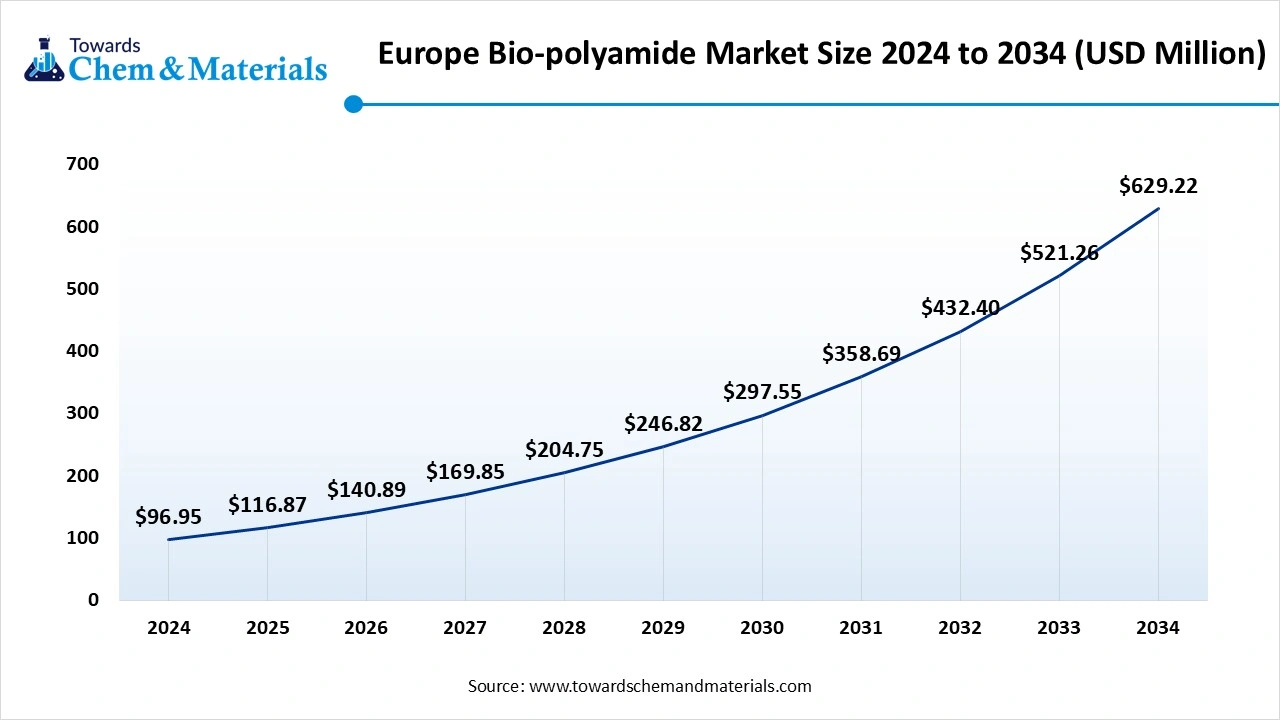
The Green Initiatives and Sustainability Initiatives in The UK Help in The Growth of The Market.
The growth of the market is driven by the growing industrial sectors in the country, due to increasing sustainability and eco-friendly product use increases the demand for bio-polyamide. The textile, automotive, and packaging industry demand for durable, lightweight, and sustainable alternatives that offer benefits to the industry and do not impact heavily on the environment heavily, which fuels the growth in the country. Major players in the bio-polyamide market, like DuPont, Honeywell International, Toray Industries, Mitsui Chemicals, and Nippon Steel Chemical, play a crucial role in the growth and development of the market in the country.
- European Union Export data, the European Union shipped out 113 polyamide shipments. The exports made by 31 exporters to 34 buyers. (Source: Volza)
Growing Industrial and Sustainability Initiatives in North America Drive the Growth of The Market
North America is expected to experience steady growth in the bio-polyamide market in the forecast period. The growing manufacturing units in the region expand the demand for the market due to its application and properties, which drive the growth. The growing construction sector in the region drives the demand for green buildings due to the rising shift towards sustainability and increasing innovation and development in the clothing sector, and demand for bio-based products and polymers boosts the growth of the market, aligning with the regulatory and government bodies' strict environmental regulations drive growth.
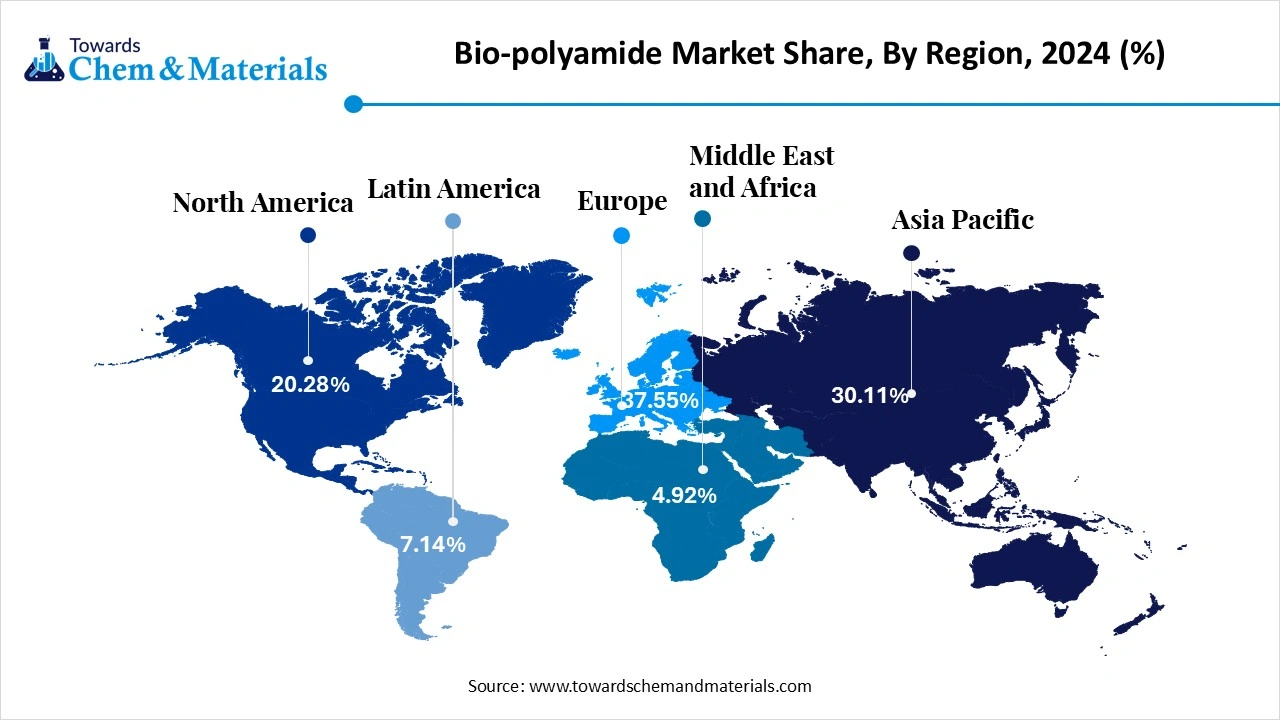
The Growing Technological Advancement in Manufacturing and Processing in The Country Drives the Growth.
The growth of the market is driven by the growing technological advancements in the country, for advancement in the processing of products to ensure enhanced properties and efficiency of the product, and product design fuels the growth of the market in the country. The growing packaging industry and demand for eco-friendly and sustainable packaging solutions with unique processing technologies for user user-friendly experience fuel the growth of the market. The country's bio-polyamide market is a promising area for growth, driven by sustainability trends, technological advancements, and supportive regulatory environments, which help in the growth and expansion of the market.
- The world shipped out 2,165,646 polyamide shipments from November 2023 to October 2024 (TTM). These exports were handled by 40,204 exporters to 46,347 buyers, showing a growth rate of 23% over the previous 12 months.(Source: Volza)
- Globally, China, Turkey, and Vietnam are the top three exporters of polyamide. China is the global leader in Materials Composite exports with 2,025,885 shipments, followed closely by Turkey with 1,348,658 shipments, and Vietnam in third place with 1,073,461 shipments.(Source: Volza)
Segmental Insights
Product Insights
Which Product Segment Dominated the Bio-Polyamide Market in 2024?
The PA-66 segment dominated the bio-polyamide market in 2024. The growing applications and properties like high melting points, good mechanical properties, chemical resistance, durability, and versatility of the product drive the demand for the market. PA66 is produced through polycondensation, where two monomers react to form a long chain polymer with amide groups through semi-crystalline thermoplastics. A wide range of applications in various industries like automotive, manufacturing, textiles, and electronics, due to its properties, boosts the growth of the market.
The PA-6 segment expects significant growth in the bio-polyamide market during the forecast period. PA6 is a versatile engineering thermoplastic polymer. The growth is driven using Materials due to their properties, like excellent mechanical strength, including strength, resistance to chemicals and other factors, and toughness fuels the growth. It is synthesised through a ring-opening polymerization process. The key properties and characteristics like moderate melting point, moisture absorption, good stability and growing demand, and adoption by automotive, electrical, textile, engineering, consumer goods, industrial machinery, and electrical industry drive the growth of the market and help in the expansion of the market.
Application Insights
How Did the Engineering Plastics Segment Dominate the Bio-Polyamide Market In 2024?
The engineering plastics segment dominated the market in 2024. The engineering plastics are a polymer that are in increasing demand due to its properties like mechanical, thermal, electrical, and chemical properties, and resistance to stress drives the demand for the market, which helps in growth. Engineering plastics are used in a wide range of applications in automotive for body parts, in electronics for devices and connectors, in aerospace for aircraft and spacecraft, in medical devices, and other industries, boosting the growth of the market.
The fiber segment expects significant growth in the bio-polyamide market during the forecast period. Fibers play a significant and crucial role in industrial applications like manufacturing and construction to improve the strength, appearance, durability, and resistance to cracking, and help in the reduction of weight. This drives the growth of the market and helps in the expansion of various industries.
End Use Insights
How did the Automotive Segment Dominate the Bio-Polyamide Market in 2024?
The automotive segment dominated the market in 2024. The growing de, and for eco-friendly lightweight materials, which have enhanced strength and durability and reduced weight, is increasing the demand for the market. The growing automotive sector and demand for biobased materials for door panels, dashboards, and seats boost the growth of the market and help in its expansion.
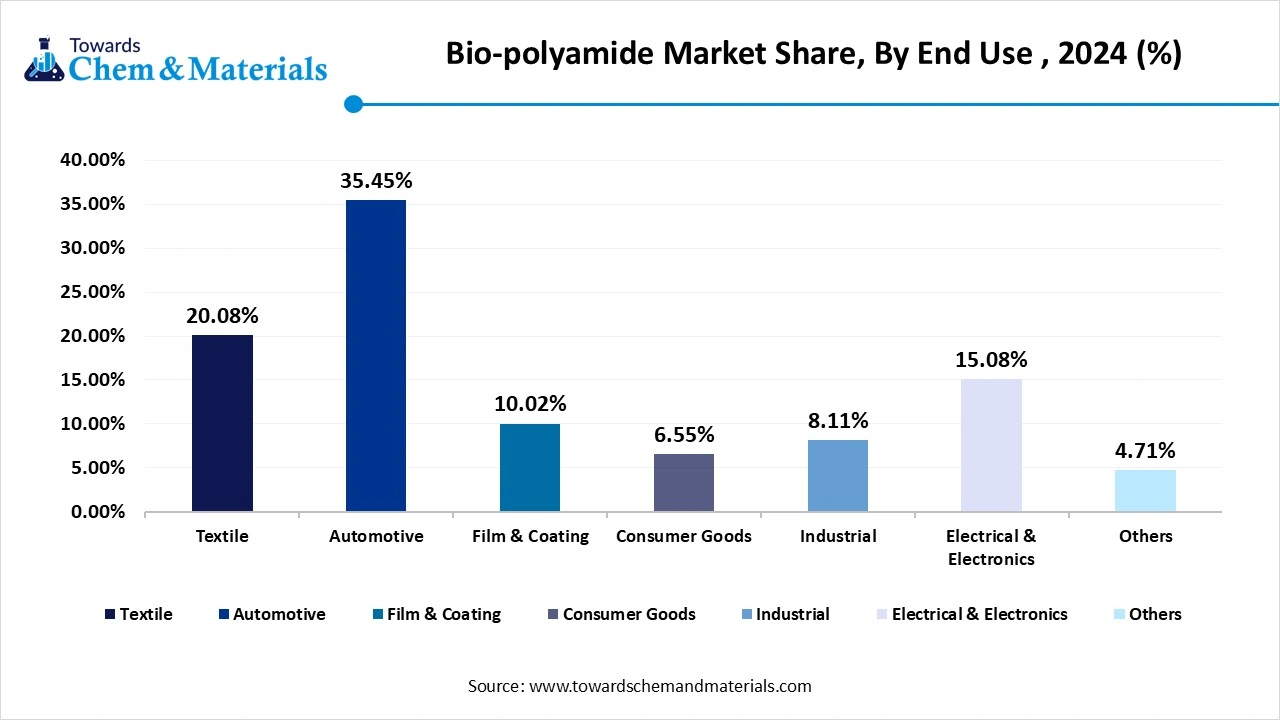
The textile segment expects significant growth in the bio-polyamide market during the forecast period. The growing demand for biobased alternatives to traditional synthetic materials to lower the environmental impact drives the demand. They are used in the manufacturing of sportswear, workwear, and fashion garments, and technical textiles, and demand for long-lasting, resistant to certain conditions, along with breathable properties, which drives the demand and helps in the growth of the market.
Recent Developments
- In April 2025, Pangaia, a British material science firm, eco fashion pioneer, launched its new addition of sustainable innovation in clothing in the nylon industry. The clothes are made of 100% biobased polymer, which is derived from castor bean oil seeds. (Source: greenqueen)
- In October 2024, Italy’s RadiciGroup launched a new range of bio-based engineering polymers. Global Marketing Manager Erico Spini introduced the Bionside portfolio, part of the company’s established Radilon family of products. (Source: plastictoday)
- In March 2025, Lululemon and ZymoChem signed the deal together to broaden its use of bio-based nylon, as announced in a recent press release. This new agreement builds on Lululemon's existing partnership with ZymoChem, which was part of a $21 million Series A funding round the company participated in last year, alongside Toyota Ventures.(Source: fashiondive)
Top Companies List
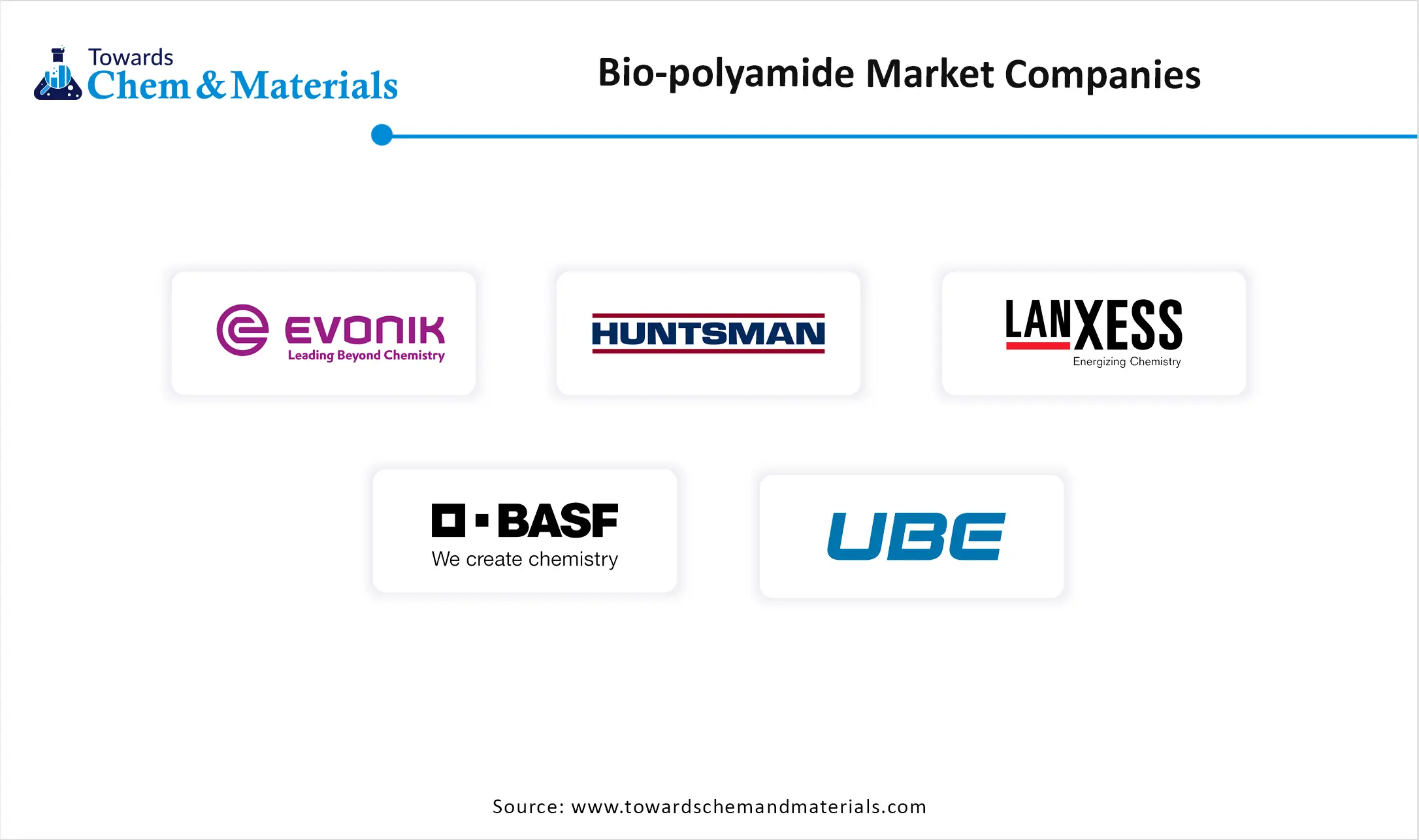
- Evonik Industries AG
- Huntsman International LLC
- LANXESS
- BASF SE
- UBE Corporation
- INVISTA
- DOMO Chemicals GmbH
- Arkema
- Asahi Kasei Corporation
- Honeywell International Inc.
- DSM
- TORAY INDUSTRIES, INC.
- Radici Partecipazioni SpA
- DuPont
- Solvay
- ZIG SHENG INDUSTRIAL CO., LTD
- Quadrant Group Limited
- LEALEA ENTERPRISE CO., LTD.
- EMS-CHEMIE HOLDING AG
Segments Covered in the report
By Product
- PA-6
- PA-66
- Specialty Polyamides
By Application
- Fiber
- Engineering Plastics
By End-use
- Textile
- Automotive
- Film & Coating
- Consumer Goods
- Industrial
- Electrical & Electronics
- Others
By Region
- North America
- U.S.
- Canada
- Europe
- Germany
- UK
- France
- Italy
- Spain
- Sweden
- Denmark
- Norway
- Asia Pacific
- China
- Japan
- India
- South Korea
- Thailand
- Latin America
- Brazil
- Mexico
- Argentina
- Middle East and Africa (MEA)
- South Africa
- UAE
- Saudi Arabia
- Kuwait
